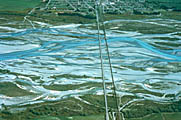 |
|
|
|
|
|
|
Rivers in cold mountain areas typically have braided channels with cross sections approchaning a rectangular shape. This is due to the relatively steep slopes, the abundance of coarse debris and the high amplitude in seasonal discharge variation. Coarse material is transported as bedload whereas fine material is carried in suspension. Meltwater from glaciers with intense basal abrasion is especially rich in fine material, giving the corresponding rivers and lakes the characteristic milky colour.
Sediment input into river systems is from
Sediment flux is related to discharge: large rivers carry more than small ones and flood discharge edvacuates more debris than normal flow. However, there is much scatter in corresponding statistical relations, because sediment flux depends more on the availability of sediments than on the transport capacity of the river. The most easily eroded material is sand, because cohesion in clay and gravity in gravel slow down the process. With increasing discharge - during the development of a flood, for instance - the typical periglacial rivers with braided channels and heavy bedload tend to pass directly to erosion without much transition in a transportation mode that is characteristic for meandering channels. |
29 August 2011 |
||
| |
||
